.MAX ERNST will-o'-the-wisp.
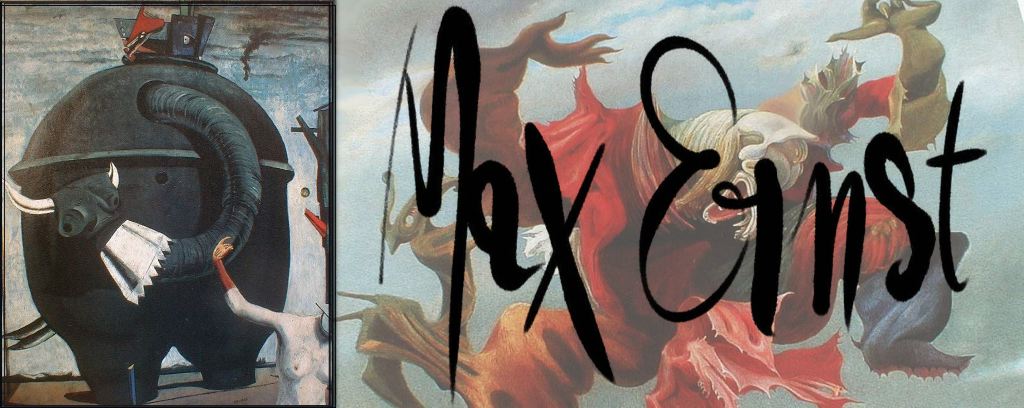 The first Surrealist painting!
It is difficult to have a look around the work of max Ernst (1891 /1976).
If one had all his works next to each other, that would make much, and one could not know that it is the same person who did them, they are so different from each other!
It is perhaps for that reason that we like Max Ernst more than other painters who never changed their painting manner over their life.
Him, he changed his ways a lot, to think and to make.
Max Ernst is like a flame. He is never motionless, he changes style, and he changes techniques… He is obliged to change place and to change nationality: he was born in Germany, he is expelled by the Nazis, he passes by France, he flees the Nazism while going to the United States, after the war, he becomes French. He does not have the fidgets; in fact wars drive him out. At that time, many German artists did the same.
In 1921, he is the first to paints a bizarre painting (that one will call “the first surrealist painting”).
He paints a funny elephant with a lid and piping. Nobody believed it is an elephant; it is rather a large pressure-cooker, or a too heavy flying saucer that could not fly. At the end of the horn there is a bull mask.
The first Surrealist painting!
It is difficult to have a look around the work of max Ernst (1891 /1976).
If one had all his works next to each other, that would make much, and one could not know that it is the same person who did them, they are so different from each other!
It is perhaps for that reason that we like Max Ernst more than other painters who never changed their painting manner over their life.
Him, he changed his ways a lot, to think and to make.
Max Ernst is like a flame. He is never motionless, he changes style, and he changes techniques… He is obliged to change place and to change nationality: he was born in Germany, he is expelled by the Nazis, he passes by France, he flees the Nazism while going to the United States, after the war, he becomes French. He does not have the fidgets; in fact wars drive him out. At that time, many German artists did the same.
In 1921, he is the first to paints a bizarre painting (that one will call “the first surrealist painting”).
He paints a funny elephant with a lid and piping. Nobody believed it is an elephant; it is rather a large pressure-cooker, or a too heavy flying saucer that could not fly. At the end of the horn there is a bull mask.
 It is starting from that masterly spanking that I was certain I would never have the faith again. I was 17 years old, I was a Royal marine commando parachutist, that was hardly worth better!
He astonished his friends with this image that nobody had never seen in painting, he calls it “the elephant Célèbes*”, I do not know why. It would be believed that it means the celebrated elephant …, it is celebrated now, one can see it in London.
(*there are some islands which one calls the Célèbes islands. That is true!)
When he becomes champion of his receipt of painting, that does not interest him anymore; he invents a new manner of making art. Many of other artists always make the same thing to improve their painting… But also because they cannot make differently since they became famous with that… It is difficult to change, their admirors would not recognize them anymore.
One does not easily recognize a painting of max Ernst.
Max Ernst always liked to change, he often tried to make differently as if it annoyed him to start again too often.
It is starting from that masterly spanking that I was certain I would never have the faith again. I was 17 years old, I was a Royal marine commando parachutist, that was hardly worth better!
He astonished his friends with this image that nobody had never seen in painting, he calls it “the elephant Célèbes*”, I do not know why. It would be believed that it means the celebrated elephant …, it is celebrated now, one can see it in London.
(*there are some islands which one calls the Célèbes islands. That is true!)
When he becomes champion of his receipt of painting, that does not interest him anymore; he invents a new manner of making art. Many of other artists always make the same thing to improve their painting… But also because they cannot make differently since they became famous with that… It is difficult to change, their admirors would not recognize them anymore.
One does not easily recognize a painting of max Ernst.
Max Ernst always liked to change, he often tried to make differently as if it annoyed him to start again too often.
“Transfers”.
(I do not know why max Ernst calls it like this. That would mean that it is a kind of transfer, as a flexible paper tattoo which one wants to put on the skin.)
When one sees for the first time, for real, a table painted by “transfer”… It is understood well that max Ernst did not paint with a brush but with something else: a piece of paper?
- “How can one paint with a bit of paper? ”
- “Max Ernst was clever. ”
 He put fluid oil-base paint on a paper or a piece of wood as on a slice of bread, then it turned over the slice on its canvas and made it slip. He was removing it with a blow to make funny effect… Trails of complicated colors. That one cannot see it on the book!
It did not mix much the colors on the piece of paper, he preferred they mix on the fabric when he was making the piece of paper slip.
It is necessary to make slice of bread slip with the two hands. At the beginning the results are not good. It often improves when one tests more, but that can irritate, then it is better to test the following day.
But one should not give up since Max Ernst succeeded in making splendid paintings with this technique.
But max Ernst did not leave his paintings like that!
He continued to paint thoroughly with a small brush on slipped and mixed paint. It revealed strange heads by improving things a little; the strange heads almost existed already in the color. It was necessary to see them and show them to the others.
(calling that "transfer" whereas it does not transfer anything at all, it is a little exaggerated!)
He should have called this technique "the slice of bread and jam turned over on the table" or "slice of bread of paint slipped on a canvas".
The "Europe after the rain" painting (L'Europe après la pluie 1940-42) is made in this manner and was thoroughly improved.
He put fluid oil-base paint on a paper or a piece of wood as on a slice of bread, then it turned over the slice on its canvas and made it slip. He was removing it with a blow to make funny effect… Trails of complicated colors. That one cannot see it on the book!
It did not mix much the colors on the piece of paper, he preferred they mix on the fabric when he was making the piece of paper slip.
It is necessary to make slice of bread slip with the two hands. At the beginning the results are not good. It often improves when one tests more, but that can irritate, then it is better to test the following day.
But one should not give up since Max Ernst succeeded in making splendid paintings with this technique.
But max Ernst did not leave his paintings like that!
He continued to paint thoroughly with a small brush on slipped and mixed paint. It revealed strange heads by improving things a little; the strange heads almost existed already in the color. It was necessary to see them and show them to the others.
(calling that "transfer" whereas it does not transfer anything at all, it is a little exaggerated!)
He should have called this technique "the slice of bread and jam turned over on the table" or "slice of bread of paint slipped on a canvas".
The "Europe after the rain" painting (L'Europe après la pluie 1940-42) is made in this manner and was thoroughly improved.
Max Ernst and frictions.
- "He rubs what… On what? "
He rubs on paper with a pencil… But he put something under his sheet.
What could one put under the sheet?
A coin of currency!
Let us test.
But what would be more surprising than a coin?
It is necessary to discover alone.
Max Ernst says that the technique is not important when one does something artistically.
Technique does not have anything mysterious or impossible, it is necessary to understand it and test it. It is as when a surprise is bought, it is not difficult to build the object inside, there are instructions…. What is more difficult is to build another object with the same pieces.
It is similar with the frictions, it is not difficult to rub a little everywhere on the sheet, it is more difficult to make another thing of it…
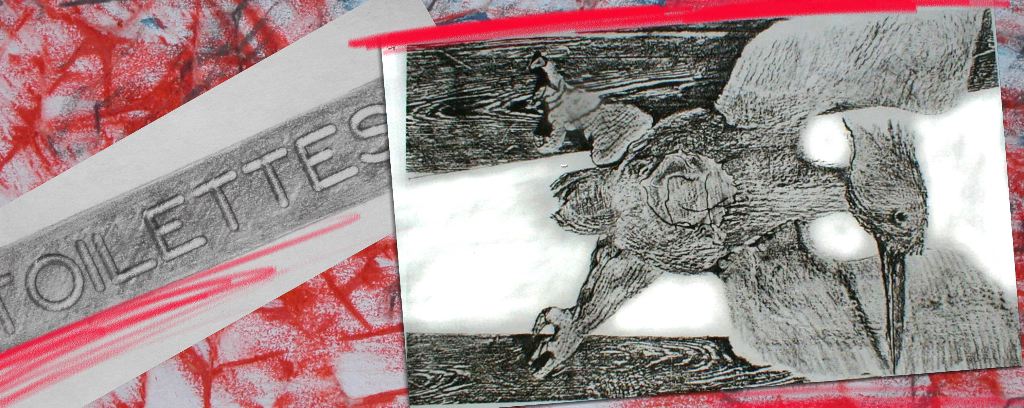 Max Ernst is timid, it does not like too much that one says that he is skilful, he does not want to discourage those who want to test, he wants to explain us that by testing, everyone could do what he does.
He is perhaps the only artist who tried to make us understand that works are easy to make when the technique is known.
Sometimes the other artists made us believe that what they did was very difficult to remake that they were the only ones being able to make it and that it was not worth to test because we were too stupid.
Max Ernst him, trusts us and told us to test.
He speaks simply.
“I remember a wood panel located opposite to my bed, I often looked at it when I was small. I still saw it a little when I was ready to deaden. I saw odd things there.
Later it was a floor which made me dream… and a little fear. Washings with the brush had accentuated the grooves of wood.
I was attracted by the ground and almost obliged to look all the time at it because of the lines and the nodes in the wood. That irritated me and at the same time I liked that, what I saw changed all the time. I approached the floor with a paper sheet in the hope to keep the traces on the sheet (like one makes with a coin). I changed regularly and slightly the sheet of place…, just a little. I obtained lines of a high degree of accuracy and I trapped the world I had located when I was standing up.
Thereafter, I placed paper sheets on other things than wood. Things that wanted to be well rub by my pencil; sheets of trees, fabric of bag, string, dry paint…
It is necessary to try in order to understand. ”
Max Ernst is timid, it does not like too much that one says that he is skilful, he does not want to discourage those who want to test, he wants to explain us that by testing, everyone could do what he does.
He is perhaps the only artist who tried to make us understand that works are easy to make when the technique is known.
Sometimes the other artists made us believe that what they did was very difficult to remake that they were the only ones being able to make it and that it was not worth to test because we were too stupid.
Max Ernst him, trusts us and told us to test.
He speaks simply.
“I remember a wood panel located opposite to my bed, I often looked at it when I was small. I still saw it a little when I was ready to deaden. I saw odd things there.
Later it was a floor which made me dream… and a little fear. Washings with the brush had accentuated the grooves of wood.
I was attracted by the ground and almost obliged to look all the time at it because of the lines and the nodes in the wood. That irritated me and at the same time I liked that, what I saw changed all the time. I approached the floor with a paper sheet in the hope to keep the traces on the sheet (like one makes with a coin). I changed regularly and slightly the sheet of place…, just a little. I obtained lines of a high degree of accuracy and I trapped the world I had located when I was standing up.
Thereafter, I placed paper sheets on other things than wood. Things that wanted to be well rub by my pencil; sheets of trees, fabric of bag, string, dry paint…
It is necessary to try in order to understand. ”
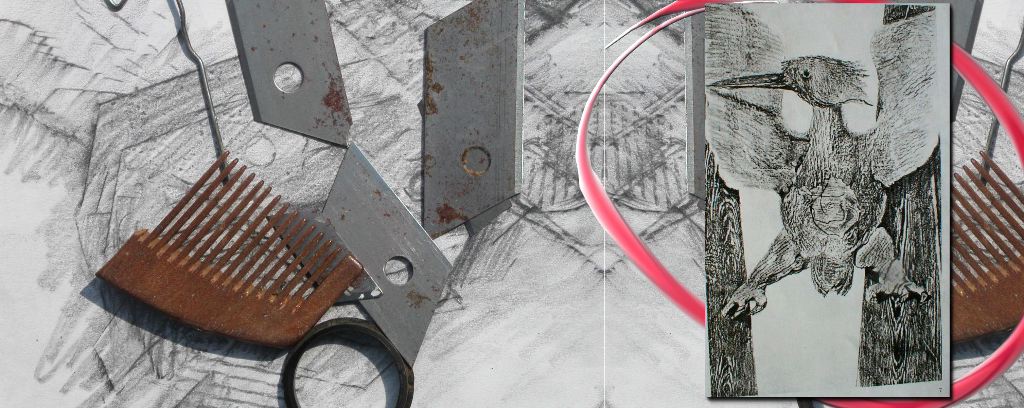
Collages of Max Ernst.
At the beginning of the century, there were not many photographs in the magazines, there were especially drawings which resembled to photos, they were carried out with a lot of tight hatchings.
If you had been children at that time, you could not have cut photographs out. You would have cut out images made of small very tight features.
Moreover, the illustrated books were rare.
… advertising leaflets did not exist. At the time of max Ernst, the postman did not leave any in the letter-boxes: Max Ernst managed differently to find images.
“One day (in 1919), whereas I looked at an illustrated book of objects (umbrellas, watches, tools, clothing, etc) I was surprised to see such different things tight beside the others, things which one does not see together usually, my eyes saw other objects, I wanted to add with the pencil some lines and hatchings between the various objects so that it gives the same images that I see in my dreams.”
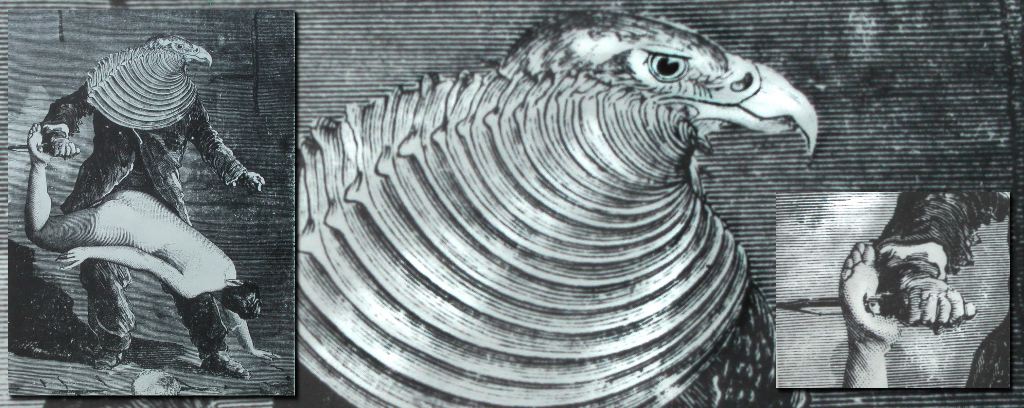 The goal of Max Ernst is simple: he wants to reverse the relationship known between the objects; he wants to propose new and unexpected relationship between the images.
The goal of Max Ernst is simple: he wants to reverse the relationship known between the objects; he wants to propose new and unexpected relationship between the images.
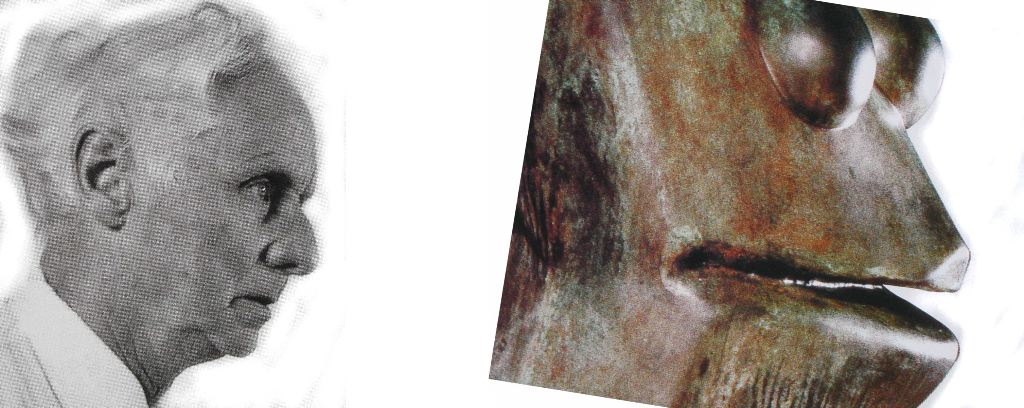 When his collage was finished, Max Ernst didn’t like that one looks at it closely there were too many defects: collage was a little dirty, with the traces of adhesive, a little ruffled paper and the marks of awkward scissors, he hid it, and he made a photograph of it. At 21th century we would say that it is better to show the photocopy than a little dirty sheet of work. Today a photocopy is not expensive; why stint ourselves, and if the collage is successful, we can offer some to all our friends.
Max Ernst really didn’t like one sees that it had stuck pieces of hatched images the ones beside the others! The photocopy, it's ideal!
Quite clever who which now will find how that was done!
- “One should not know how that has been done. ”
One can also make collages with pieces of various photos. That is called your “photomontages”.
Another artist, Man Ray, said that he was a “fautographe” and not a “photographer”.
Max Ernst has never been a “fautographe” since he never stuck pieces of photographs…, that almost did not exist at his time, otherwise he would have done it too.
When his collage was finished, Max Ernst didn’t like that one looks at it closely there were too many defects: collage was a little dirty, with the traces of adhesive, a little ruffled paper and the marks of awkward scissors, he hid it, and he made a photograph of it. At 21th century we would say that it is better to show the photocopy than a little dirty sheet of work. Today a photocopy is not expensive; why stint ourselves, and if the collage is successful, we can offer some to all our friends.
Max Ernst really didn’t like one sees that it had stuck pieces of hatched images the ones beside the others! The photocopy, it's ideal!
Quite clever who which now will find how that was done!
- “One should not know how that has been done. ”
One can also make collages with pieces of various photos. That is called your “photomontages”.
Another artist, Man Ray, said that he was a “fautographe” and not a “photographer”.
Max Ernst has never been a “fautographe” since he never stuck pieces of photographs…, that almost did not exist at his time, otherwise he would have done it too.
The scraping of Max Ernst.
Lottery it is scraping, one scrapes on the black to find a good number… One hopes to gain!
Max Ernst likes to scrape his painting, that doesn’t say that he wants to pass through it; it is not either because his painting pricks and that he wants to make it feels good.
He scrapes to gain, his painting will be sold better…, it should not be forgotten that he earns his living by selling his works.
Here is how he removes paint with scraping:
1 - He installs a canvas.
2 - He paints all the surface of the white canvas. He paints with oil-based paint; it takes a long time to dry.
3 - He must wait.
4 - Then, he paints a second layer of color, he can choose the color, but he can use rests of paint.
5 - He waits until it dries.
6 - He can start once again if he wants it.
Thus there are several layers of more or less dry paint the ones on top of the others.
7 - It is here that his true work starts; he takes a scraper, a knife, and he tries to remove the layers of paint: as removing the ice of the windshield of cars in winter. He won’t remove all; otherwise it wasn’t worth to put all these layers of paint on top of each others. Anyway that would be difficult to remove all since paint is dry and hard.
 One can scrape as he likes, the colors of the lower part will be revealed, and that will never make the similar effect as if he used a brush.
One can also scrape the superimposed layers of color:
1 - In greasy pastels.
2 - In gouache.
3 - In acrylic painting.
4 - If the three are mixed that can work.
Often the table on which one works is too smooth. That would be better to be on something rougher like an old table, a plank. In any case, one finds things more beautiful with scraping when there are small bumps.
One can scrape as he likes, the colors of the lower part will be revealed, and that will never make the similar effect as if he used a brush.
One can also scrape the superimposed layers of color:
1 - In greasy pastels.
2 - In gouache.
3 - In acrylic painting.
4 - If the three are mixed that can work.
Often the table on which one works is too smooth. That would be better to be on something rougher like an old table, a plank. In any case, one finds things more beautiful with scraping when there are small bumps.
 Max Ernst is complicated; he can mix all the techniques mentioned before: Transfers, collages, frictions, scrapings…
He can make things slip, wait until that dries, to scrape, rub and especially paint over, like the other painters. He can paint with precision, or even make a scribble.
Max Ernst is complicated; he can mix all the techniques mentioned before: Transfers, collages, frictions, scrapings…
He can make things slip, wait until that dries, to scrape, rub and especially paint over, like the other painters. He can paint with precision, or even make a scribble.
 Max Ernst is not a beginner! At the beginning it is better do experiments with each technique that allow beautiful discoveries, then, to mix some of them to obtain a more complicated result, but it is difficult to make a success out of something confusing.
He neither, he did not always succeed.
So it is necessary to continue to scrape…
Max Ernst is not a beginner! At the beginning it is better do experiments with each technique that allow beautiful discoveries, then, to mix some of them to obtain a more complicated result, but it is difficult to make a success out of something confusing.
He neither, he did not always succeed.
So it is necessary to continue to scrape…
.


2 Comments:
What a great melding of the personality, stylistic diversity and details of the painter's material.
Nice work.
Great post!
Post a Comment
<< Home